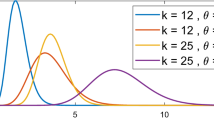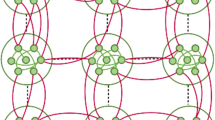Abstract
Recent progress in the areas of network science and control has shown a significant promise in understanding and analyzing epidemic processes. A well-known model to study epidemics processes used by both control and epidemiological research communities is the susceptible–infected–susceptible (SIS) dynamics to model the spread of disease/viruses over contact networks of infected and susceptible individuals. The SIS model has two metastable equilibria: one is called the endemic equilibrium and the other is known as the disease-free or healthy-state equilibrium. Control theory provides the tools to design control actions (allocating curing or vaccination resources) in order to achieve and stabilize the disease-free equilibrium. However, the control actions are often designed for the entire community. Based on the ideas developed in graph-theoretic control, this paper aims to study allocating curing resources to a target group instead of the entire community. This target group is selected based on centrality rank in different types of random networks. Our results show that specific graph properties are involved in the epidemic control. In particular, we show that (1) the clustering-coefficient and (2) the degree distribution of the network are effective in the selection of these target groups for epidemic control.


Similar content being viewed by others
References
Barabási A, Albert R (1999) Emergence of scaling in random networks. Science 286:509–512
Bonacich P, Lloyd P (2001) Eigenvector-like measures of centrality for asymmetric relations. Soc Netw 23:191–201
Doostmohammadian M, Khan UA (2019) On the controllability of clustered Scale-Free networks. J Complex Netw 8(1):cnz014
Doostmohammadian M, Pourazarm S, Khan UA (2014) Distributed algorithm for shortest path problem via randomized strategy. In: IEEE 11th international conference on networking, sensing and control, pp 463–467
Drakopoulos K, Ozdaglar A, Tsitsiklis JN (2014) An efficient curing policy for epidemics on graphs. IEEE Trans Netw Sci Eng 1:67–75
Ghalmane Z, El Hassouni M, Cherifi H (2019) Immunization of networks with non-overlapping community structure. Soc Netw Anal Min 9:45
Godsil C, Royle GF (2013) Algebraic graph theory. Springer, Berlin
Gourdin E, Omic J, Van Mieghem P (2011) Optimization of network protection against virus spread. In: 8th international workshop on the design of reliable communication networks (DRCN), pp 86–93
Holme P, Kim B (2002) Growing scale-free networks with tunable clustering. Phys Rev E 65:026107
Holme P, Kim B, Yoon C, Han S (2002) Attack vulnerability of complex networks. Phys Rev E 65:056109
Khanafer A (2015) Information spread in networks: games, optimal control, and stabilization. PhD thesis, University of Illinois at Urbana-Champaign
Krishnaraj PM, Mohan A, Srinivasa KG (2017) Performance of procedures for identifying influentials in a social network: prediction of time and memory usage as a function of network properties. Soc Netw Anal Min 7:34
Lawyer G (2015) Understanding the influence of all nodes in a network. Sci Rep 5:1–9
Li C, Wang H, Van Mieghem P (2013) Epidemic threshold in directed networks. Phys Rev E 88:062802
Lü L et al (2016) Vital nodes identification in complex networks. Phys Rep 650:1–63
Milanese A, Sun J, Nishikawa T (2010) Approximating spectral impact of structural perturbations in large networks. Phys Rev E 81:046112
Mislove A, Marcon M, Gummadi KP, Druschel P, Bhattacharjee B (2007) Measurement and analysis of online social networks. In: 7th ACM SIGCOMM conference on internet measurement. ACM, New York, pp 29–42 (2007)
More JS, Lingam C (2019) A gradient-based methodology for optimizing time for influence diffusion in social networks. Soc Netw Anal Min 9:5
Mussumeci E, Coelho FC (2018) Reconstructing news spread networks and studying its dynamics. Soc Netw Anal Min 8:6
Newman MEJ (2002a) Spread of epidemic disease on networks. Phys Rev E 66:016128
Newman MEJ (2002b) Assortative mixing in networks. Phys Rev Lett 89:208701
Nishikawa T, Motter AE (2010) Network synchronization landscape reveals compensatory structures, quantization, and the positive effect of negative interactions. Proc Natl Acad Sci 107:10342–10347
Nowzari C, Preciado VM, Pappas GJ (2016) Analysis and control of epidemics: a survey of spreading processes on complex networks. IEEE Control Syst Mag 36:26–46
Nowzari C, Preciado VM, Pappas GJ (2017) Optimal resource allocation for control of networked epidemic models. IEEE Trans Control Netw Syst 3:159–169
Ogura M, Preciado VM (2016) Stability of spreading processes over time-varying large-scale networks. IEEE Trans Netw Sci Eng 3:44–57
Runka A, White T (2015) Towards intelligent control of influence diffusion in social networks. Soc Netw Anal Min 5:9
Sahneh F, Scoglio C (2011) Epidemic spread in human networks. In: 50th IEEE conference on decision and control and European control conference, pp 3008–3013
Sarkar S, Guo R, Shakarian P (2019) Using network motifs to characterize temporal network evolution leading to diffusion inhibition. Soc Netw Anal Min 9:14
Smieszek T, Salathé M (2013) A low-cost method to assess the epidemiological importance of individuals in controlling infectious disease outbreaks. BMC Med 11:35
Sun S et al (2016) Impact of degree heterogeneity on attack vulnerability of interdependent networks. Sci Rep 6:32983
Toivonen R, Onnela J, Saramäki J, Hyvönen J, Kaski K (2006) A model for social networks. Phys A Stat Mech Appl 371:851–860
Van Mieghem P, Omic J (2013) In-homogeneous virus spread in networks. Preprint arXiv:1306.2588
Van Mieghem P et al (2011) Decreasing the spectral radius of a graph by link removals. Phys Rev E 84:016101
Watanabe T, Masuda N (2010) Enhancing the spectral gap of networks by node removal. Phys Rev E 82:046102
Watts DJ, Strogatz SH (1998) Collective dynamics of small-world networks. Nature 393:440–442
You K, Tempo R, Qiu L (2009) Efficient control of epidemics over random networks. ACM SIGMETRICS Perform Eval Rev 37:1–12
You K, Tempo R, Qiu L (2016) Distributed algorithms for computation of centrality measures in complex networks. IEEE Trans Autom Control 62:2080–2094
Acknowledgements
The authors would like to thank Professor Glenn Lawyer from Max-Planck-Institute for Informatics for helpful comments and discussion.
Author information
Authors and Affiliations
Corresponding author
Additional information
Publisher's Note
Springer Nature remains neutral with regard to jurisdictional claims in published maps and institutional affiliations.
Rights and permissions
About this article
Cite this article
Doostmohammadian, M., Rabiee, H.R. & Khan, U.A. Centrality-based epidemic control in complex social networks. Soc. Netw. Anal. Min. 10, 32 (2020). https://doi.org/10.1007/s13278-020-00638-7
Received:
Revised:
Accepted:
Published:
DOI: https://doi.org/10.1007/s13278-020-00638-7




